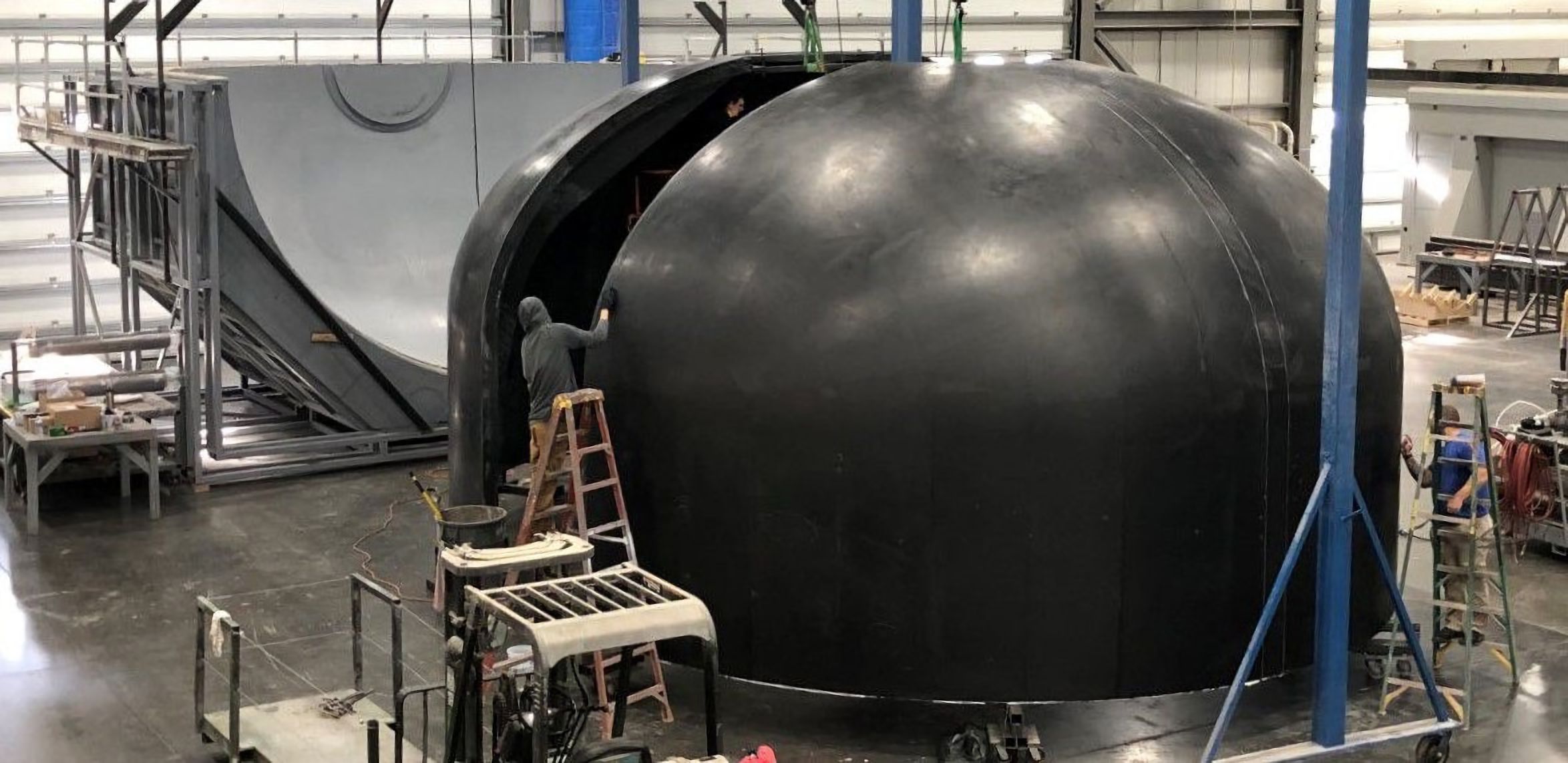

News
Rocket Lab assembling first reusable Neutron rocket hardware
Rocket Lab appears to have made significant progress since revealing the state of hardware development for its next-generation Neutron rocket in a September 2022 investor update.
At the time, the company shared photos of early work on prototypes of smaller Neutron structural elements, as well as progress building the giant molds that will be used to ‘lay up’ the rocket’s carbon fiber composite tanks and airframe. Rocket Lab also showed off acquisitions of some of the supersized manufacturing equipment that will be used to build the giant rocket, as well as the beginnings of a dedicated Neutron factory in Virginia.
Four months later, photos shared by CEO Peter Beck show that Rocket Lab has progressed to full-scale carbon fiber hardware manufacturing. In December 2022, Beck shared a photo of a full-size Neutron tank dome in the middle of production. A month later, Beck shared a photo of work on both halves of a Neutron booster tank dome. Measuring around seven meters (23 ft) wide, the latter component is already on track to become one of the largest carbon fiber structures ever prepared for a rocket once the halves are joined. And once two more halves are built and assembled, Rocket Lab could soon be ready to start testing full-scale Neutron tank hardware – a crucial milestone for any new rocket.
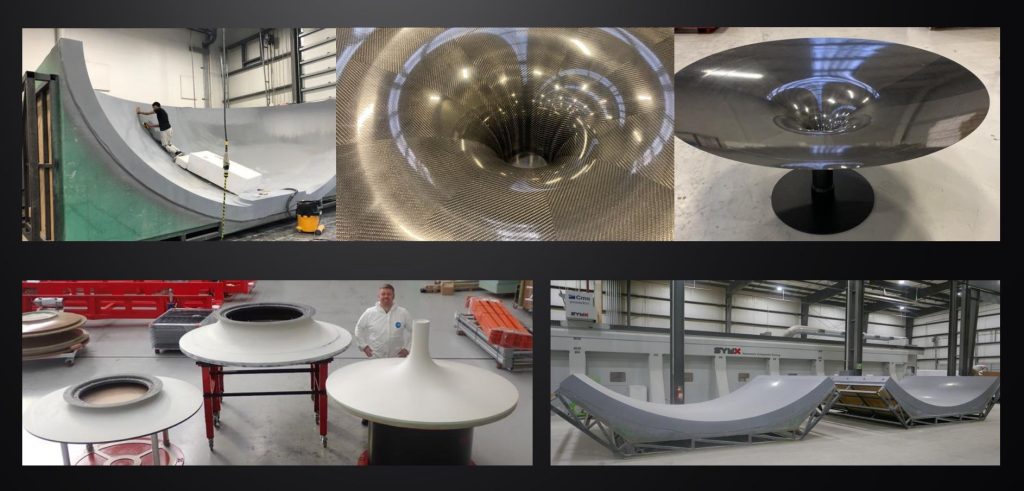
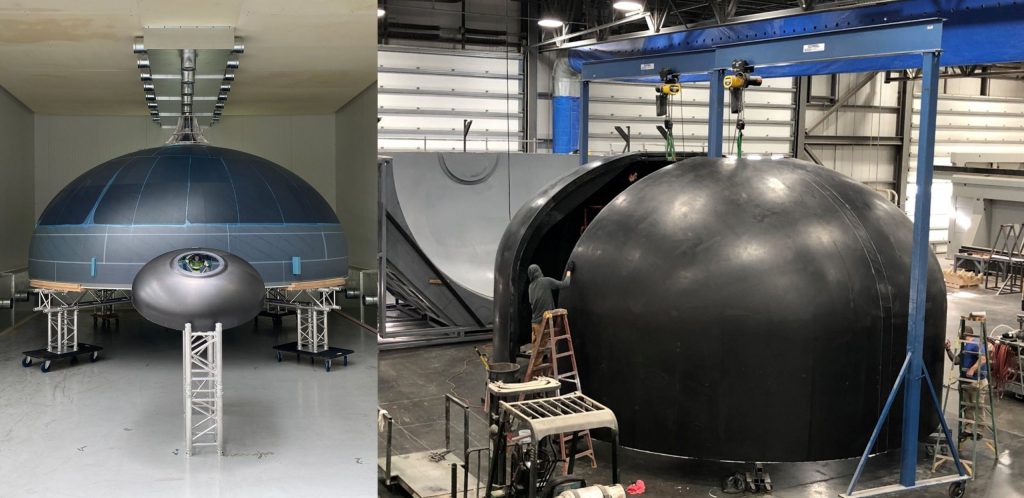
The update that's rolling out to the fleet makes full use of the front and rear steering travel to minimize turning circle. In this case a reduction of 1.6 feet just over the air— Wes (@wmorrill3) April 16, 2024
Announced in March 2021 and properly unveiled in December 2021, Neutron is a partially-reusable two-stage rocket designed to launch up to 15 tons to Low Earth Orbit (LEO) using liquid methane and oxygen propellant. Neutron measures 42.8 meters (140.4 ft) tall and up to seven meters (23 ft) wide. Its stout, ballistically-optimized design means that it’s simultaneously 40% shorter and up to 190% wider than SpaceX’s workhorse Falcon 9 rocket.
Design differences aside, Neutron is the first rocket that has been obviously designed as an answer to Falcon 9, which has become one of the most prolific, cost-effective, and routinely reusable rockets in the world over the last five or so years. Depending on how much Rocket Lab can sell Neutron for while still breaking even, Neutron has the potential to give Falcon 9 a serious run for its money – or at least force SpaceX to lower its prices. Like Falcon 9, Neutron will have a reusable booster, a reusable payload fairing, and an expendable upper stage. Its booster will also have nine (Archimedes) engines and the upper stage will be powered by one engine. At liftoff, Neutron will produce up to 674 tons (1.49M lbf) of thrust to Falcon 9’s 770 tons (1.7M lbf).
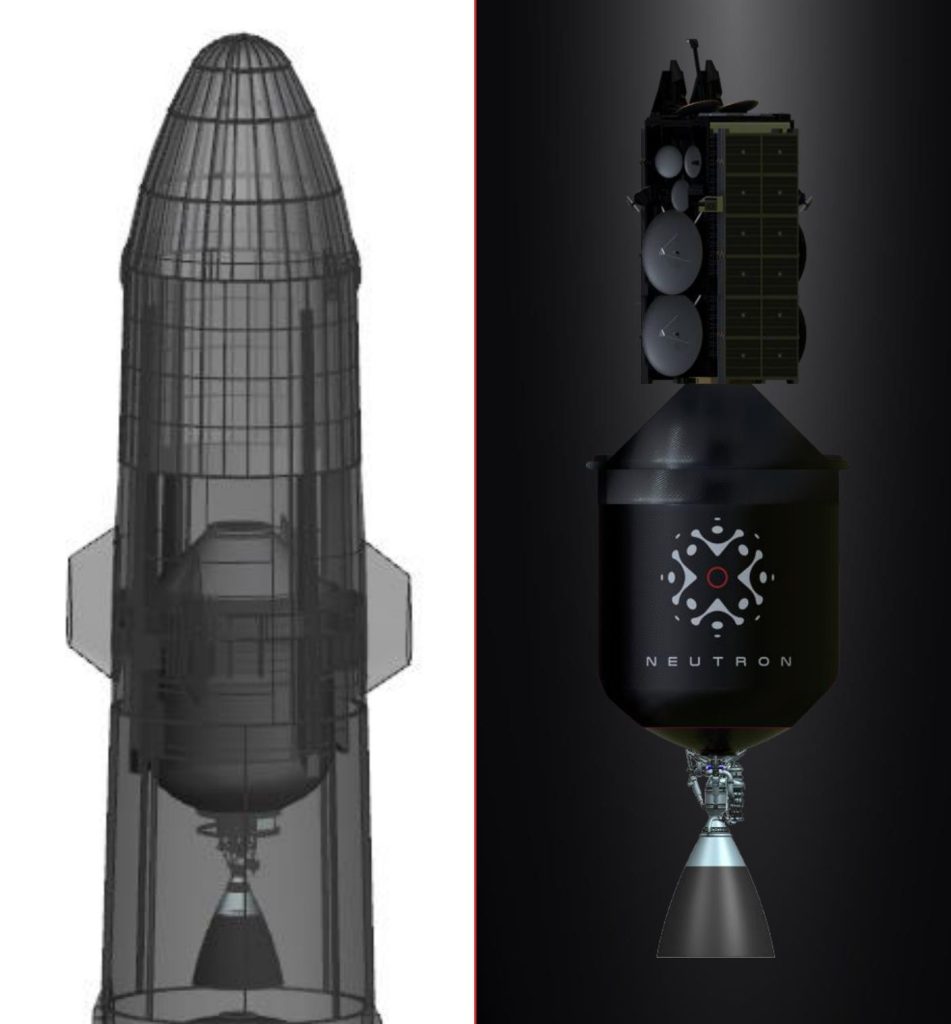
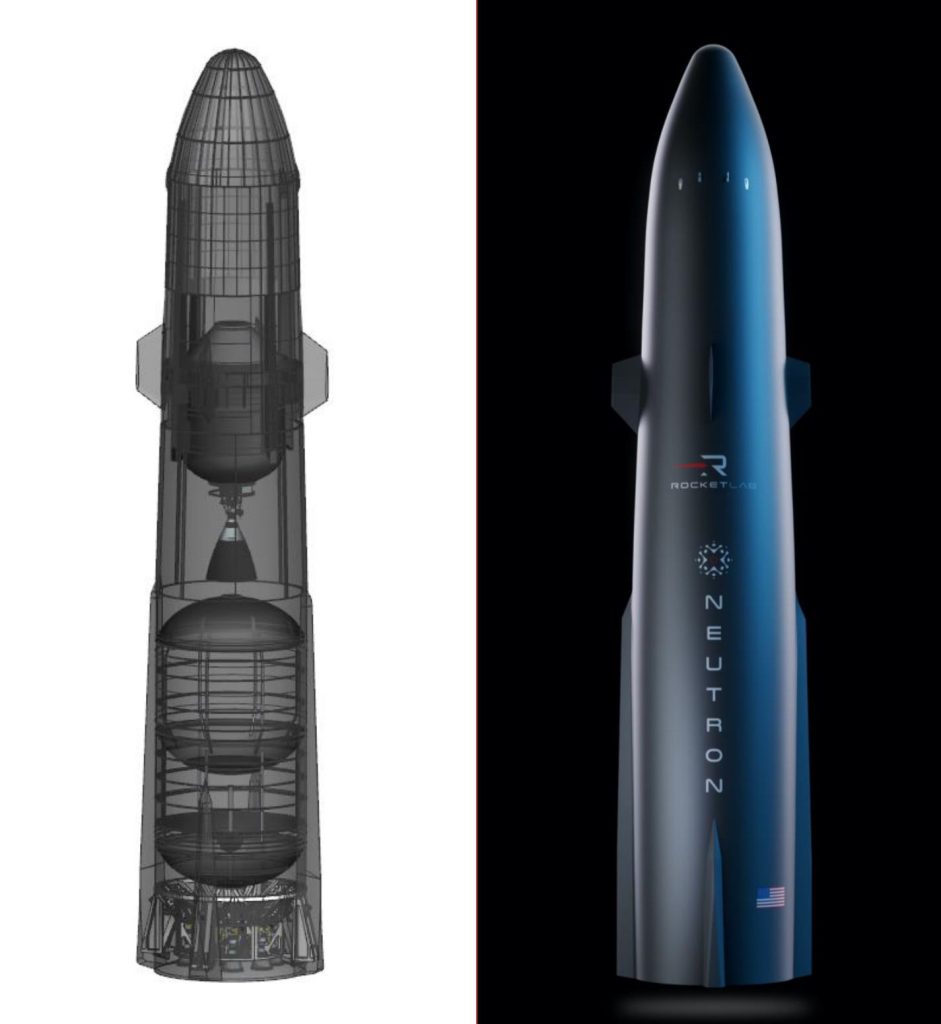
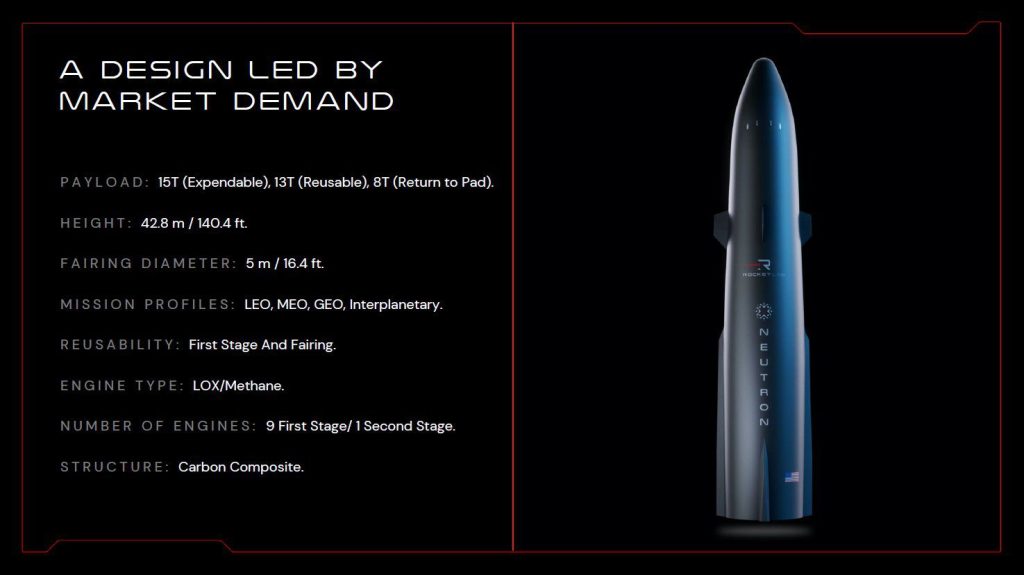
Unlike Falcon 9, Neutron’s similarly-sized reusable fairing is integral, meaning that it will stay permanently attached to the booster. But despite the added mass of the integral fairing and the rocket’s significantly shorter layout, Rocket Lab says that Neutron will be able to launch up to 13 tons (~28,700 lb) to LEO if the booster lands on a barge downrange. Using the same approach with a deployable fairing, Falcon 9 has launched up to 16.7 tons (~36,800 lb) to LEO. That 23% performance gap may seem significant, but the reality is that only SpaceX’s own Starlink and Dragon missions have ever needed Falcon 9 to launch more than 13 tons to orbit.
If Neutron can consistently launch ~25% less payload than Falcon 9 to all Earth and near-Earth orbits, virtually every commercial launch contract that’s currently a SpaceX shoo-in could be within reach of Rocket Lab within several years. The challenge, of course, is building Neutron and making sure the ambitious rocket and its clean-sheet Archimedes engine work as expected and can be reused as easily as Falcon 9.
The company is attempting to get there with its far smaller Electron vehicle, but Rocket Lab has never reused a rocket. And five and a half years after Electron’s debut, the company has never launched more than nine times in one year. SpaceX is about to reuse a Falcon booster for the 140th time and launched 61 times in 2022 – a lead that may prove almost impossible to close. There’s also the fact that the size gap between Rocket Lab’s rockets is so extreme that Neutron could likely launch a fully-fueled Electron into orbit.
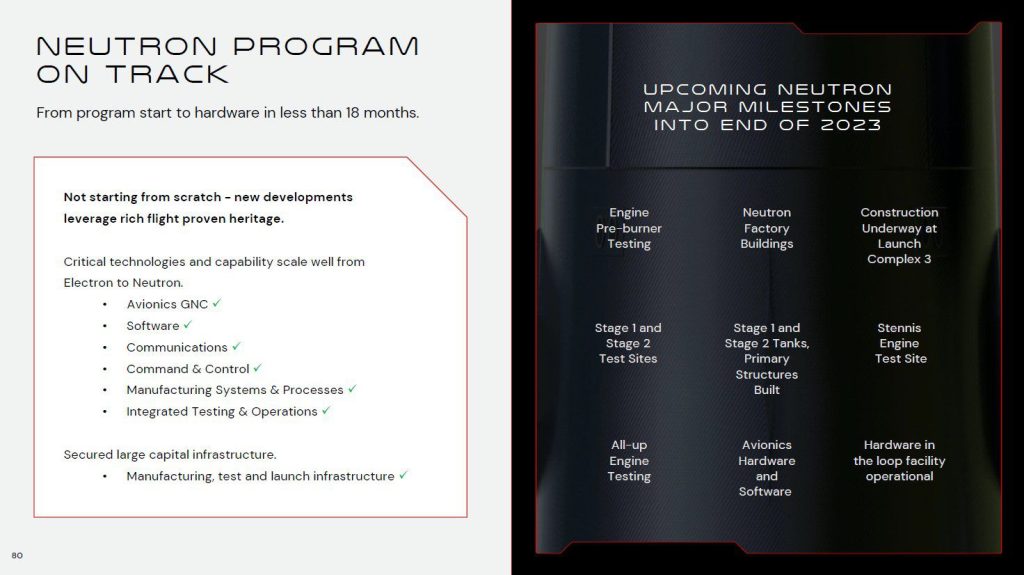
But again, SpaceX serves as a demonstration that what Rocket Lab hopes to achieve is not impossible. SpaceX went directly from Falcon 1 (about twice as large as Electron) to Falcon 9 V1.0 (about 30% smaller than Neutron) after just two successful launches of the smaller rocket. Electron has successfully launched 29 times since May 2017 and Rocket Lab is already learning about reusability through the smaller rocket. The challenges facing Rocket Lab are huge, but Neutron still remains the most promising SpaceX competitor currently in development. Kicking off full-scale Neutron tank testing just 2-3 years after the rocket was revealed would only reiterate its strengths. Stay tuned to see how much Neutron progress Rocket Lab can make in 2023.
News
Tesla launches in India with Model Y, showing pricing will be biggest challenge
Tesla finally got its Model Y launched in India, but it will surely come at a price for consumers.

Tesla has officially launched in India following years of delays, as it brought its Model Y to the market for the first time on Tuesday.
However, the launch showed that pricing is going to be its biggest challenge. The all-electric Model Y is priced significantly higher than in other major markets in which Tesla operates.
On Tuesday, Tesla’s Model Y went up for sale for 59,89,000 rupees for the Rear-Wheel Drive configuration, while the Long Range Rear-Wheel Drive was priced at 67,89,000.
This equates to $69,686 for the RWD and $78,994 for the Long Range RWD, a substantial markup compared to what these cars sell for in the United States.
🚨 Here’s the difference in price for the Tesla Model Y in the U.S. compared to India.
🚨 59,89,000 is $69,686
🚨 67,89,000 is $78,994 pic.twitter.com/7EUzyWLcED— TESLARATI (@Teslarati) July 15, 2025
Deliveries are currently scheduled for the third quarter, and it will be interesting to see how many units they can sell in the market at this price point.
The price includes tariffs and additional fees that are applied by the Indian government, which has aimed to work with foreign automakers to come to terms on lower duties that increase vehicle cost.
Tesla Model Y seen testing under wraps in India ahead of launch
There is a chance that these duties will be removed, which would create a more stable and affordable pricing model for Tesla in the future. President Trump and Indian Prime Minister Narendra Modi continue to iron out those details.
Maharashtra Chief Minister Devendra Fadnavis said to reporters outside the company’s new outlet in the region (via Reuters):
“In the future, we wish to see R&D and manufacturing done in India, and I am sure at an appropriate stage, Tesla will think about it.”
It appears to be eerily similar to the same “game of chicken” Tesla played with Indian government officials for the past few years. Tesla has always wanted to enter India, but was unable to do so due to these import duties.
India wanted Tesla to commit to building a Gigafactory in the country, but Tesla wanted to test demand first.
It seems this could be that demand test, and the duties are going to have a significant impact on what demand will actually be.
Elon Musk
Tesla ups Robotaxi fare price to another comical figure with service area expansion
Tesla upped its fare price for a Robotaxi ride from $4.20 to, you guessed it, $6.90.

Tesla has upped its fare price for the Robotaxi platform in Austin for the first time since its launch on June 22. The increase came on the same day that Tesla expanded its Service Area for the Robotaxi ride-hailing service, offering rides to a broader portion of the city.
The price is up from $4.20, a figure that many Tesla fans will find amusing, considering CEO Elon Musk has used that number, as well as ’69,’ as a light-hearted attempt at comedy over the past several years.
Musk confirmed yesterday that Tesla would up the price per ride from that $4.20 point to $6.90. Are we really surprised that is what the company decided on, as the expansion of the Service Area also took effect on Monday?
But the price is now a princely $6.90, as foretold in the prophecy 😂
— Elon Musk (@elonmusk) July 14, 2025
The Service Area expansion was also somewhat of a joke too, especially considering the shape of the new region where the driverless service can travel.
I wrote yesterday about how it might be funny, but in reality, it is more of a message to competitors that Tesla can expand in Austin wherever it wants at any time.
Tesla’s Robotaxi expansion wasn’t a joke, it was a warning to competitors
It was only a matter of time before the Robotaxi platform would subject riders to a higher, flat fee for a ride. This is primarily due to two reasons: the size of the access program is increasing, and, more importantly, the service area is expanding in size.
Tesla has already surpassed Waymo in Austin in terms of its service area, which is roughly five square miles larger. Waymo launched driverless rides to the public back in March, while Tesla’s just became available to a small group in June. Tesla has already expanded it, allowing new members to hail a ride from a driverless Model Y nearly every day.
The Robotaxi app is also becoming more robust as Tesla is adding new features with updates. It has already been updated on two occasions, with the most recent improvements being rolled out yesterday.
Tesla updates Robotaxi app with several big changes, including wider service area
News
Tesla Model Y and Model 3 dominate U.S. EV sales despite headwinds
Tesla’s two mainstream vehicles accounted for more than 40% of all EVs sold in the United States in Q2 2025.

Tesla’s Model Y and Model 3 remained the top-selling electric vehicles in the U.S. during Q2 2025, even as the broader EV market dipped 6.3% year-over-year.
The Model Y logged 86,120 units sold, followed by the Model 3 at 48,803. This means that Tesla’s two mainstream vehicles accounted for 43% of all EVs sold in the United States during the second quarter, as per data from Cox Automotive.
Tesla leads amid tax credit uncertainty and a tough first half
Tesla’s performance in Q2 is notable given a series of hurdles earlier in the year. The company temporarily paused Model Y deliveries in Q1 as it transitioned to the production of the new Model Y, and its retail presence was hit by protests and vandalism tied to political backlash against CEO Elon Musk. The fallout carried into Q2, yet Tesla’s two mass-market vehicles still outsold the next eight EVs combined.
Q2 marked just the third-ever YoY decline in quarterly EV sales, totaling 310,839 units. Electric vehicle sales, however, were still up 4.9% from Q1 and reached a record 607,089 units in the first half of 2025. Analysts also expect a surge in Q3 as buyers rush to qualify for federal EV tax credits before they expire on October 1, Cox Automotive noted in a post.
Legacy rivals gain ground, but Tesla holds its commanding lead
General Motors more than doubled its EV volume in the first half of 2025, selling over 78,000 units and boosting its EV market share to 12.9%. Chevrolet became the second-best-selling EV brand, pushing GM past Ford and Hyundai. Tesla, however, still retained a commanding 44.7% electric vehicle market share despite a 12% drop in in Q2 revenue, following a decline of almost 9% in Q1.
Incentives reached record highs in Q2, averaging 14.8% of transaction prices, roughly $8,500 per vehicle. As government support winds down, the used EV market is also gaining momentum, with over 100,000 used EVs sold in Q2.
Q2 2025 Kelley Blue Book EV Sales Report by Simon Alvarez on Scribd
-

 Elon Musk2 weeks ago
Elon Musk2 weeks agoTesla investors will be shocked by Jim Cramer’s latest assessment
-

 News3 days ago
News3 days agoTesla debuts hands-free Grok AI with update 2025.26: What you need to know
-

 Elon Musk1 week ago
Elon Musk1 week agoElon Musk confirms Grok 4 launch on July 9 with livestream event
-

 Elon Musk5 days ago
Elon Musk5 days agoxAI launches Grok 4 with new $300/month SuperGrok Heavy subscription
-

 News2 weeks ago
News2 weeks agoTesla Model 3 ranks as the safest new car in Europe for 2025, per Euro NCAP tests
-

 Elon Musk2 weeks ago
Elon Musk2 weeks agoxAI’s Memphis data center receives air permit despite community criticism
-

 News5 days ago
News5 days agoTesla begins Robotaxi certification push in Arizona: report
-

 Elon Musk2 weeks ago
Elon Musk2 weeks agoTesla scrambles after Musk sidekick exit, CEO takes over sales















